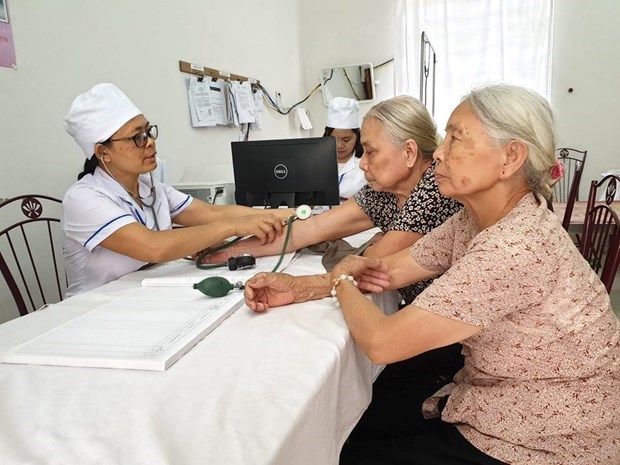Alarms on low fertility in urban areas
 (Photo: VNA)
(Photo: VNA)
Hanoi (VNA) - Currently, the average life expectancy of Vietnamese people is 72.1 years old for men and 82.3 years old for women (the average is 76.6 years old). In recent years, population work has ensured that the country has a reasonable population structure to meet the requirements of economic development. However, in the new situation, the population work has faced many challenges in fertility among regions.
To better understand this issue, VietnamPlus e-newspaper correspondent had an interview with Mr. Nguyen Doan Tu - General Director of the General Department of Population and Family Planning (Ministry of Health).
Successfully controlling fast population growth
- How do you evaluate the achievements of the population work in the past time?
Nguyen Doan Tu: After many years of implementing Resolution No. 04-NQ/HNTW on January 14, 1993 of the Fourth Conference of the Party Central Committee (VII tenure) on population policy and family planning (Resolution 4), the population work in our country has achieved important achievements in terms of both awareness and implementation.
The average number of children of a couple of childbearing age reduced rapidly, reaching replacement level (2.1 children) in 2006, 10 years earlier than the target set by Resolution 4 and maintained for more than a decade. The model of a two-child family has become a common social norm. The population growth rate so fast has been successfully controlled. The population structure has positive changes.
 Nguyen Doan Tu - General Director of General Department of Population - Family Planning (Ministry of Health) (Photo:Vietnam+)
Nguyen Doan Tu - General Director of General Department of Population - Family Planning (Ministry of Health) (Photo:Vietnam+)According to statistics, Vietnam's population in 2018 was about 95 million. It is estimated that the population size has been reduced by about 20 million thanks to appropriate population-family planning policies in recent years. The recent achievements in population work have contributed significantly to socio-economic development, poverty reduction and people's living standards improvement.
- What is the focus of the population work in the new situation?
Nguyen Doan Tu: On October 25, 2017, the Sixth Conference of the Party Central Committee (XII tenure) issued Resolution No. 21/NQ-TW on population work in the new situation (Resolution 21), clearly stating the point of continued directing the focus of population policy from family planning to population and development.
This is in line with the orientation of the International Conference on Population and Development held in Cairo, Egypt in 1994 and the theme of the World Population Day 2019 of the United Nations Population Fund.
This is also in line with the orientation of the Population and Development Summit to be held in the near future in Nairobi from 12-14 November 2019.
Severe gender imbalance
- Currently, there is information that, in many provinces fertility drops at a low and worrisome level. Can you tell us which provinces they are? And for these localities, what strategies do we need to increase fertility?
Nguyen Doan Tu: Currently, Vietnam has achieved and maintained replacement fertility on national scale. The average number of children per woman has decreased from 3.74 in 1992 to reach replacement fertility of 2.09 children in 2006 and continues to be maintained up to now.
In my opinion, one of the challenges of the current population work is that although the national fertility rate is about 2 children per woman of reproductive age, in some urban and developed socio-economic regions, fertility has dropped to a lower level than the replacement fertility. Typically: Dong Thap: 1.34 children/woman, Ho Chi Minh City: 1.36 children/woman, Ba Ria Vung Tau: 1.37 children/woman, Hau Giang: 1.53 children/woman.
In order to raise fertility in these provinces, in the immediate future, the population sector has changed the communication message in these provinces such as: "Each couple should have two children," develop and implement mechanisms and policies in order to support and encourage people to have enough children, prepare and submit to the Government for approval a scheme on adjusting fertility among regions and subjects by 2030.
- On the issue of gender imbalance at birth has there been more positive changes compared to 10 years ago?
Nguyen Doan Tu: Currently, the issue of sex imbalance at birth has become serious and increasingly widespread, both in urban and rural areas. Normally, this ratio ranges from 103-107 boys for every 100 girls.
In Vietnam, the peak was 113.8/100 in 2013, then decreased to 112.2/100 in 2014 and 2016, 112.1/100 in 2015 and 2017, in 2018 it increased to 115.1 boys for every 100 girls born. However, to achieve the goal set by Resolution21/NQ-TW on the work of the population in the new situation which is to reduce the sex ratio at birth by 2030 to less than 109 boys/100 girls born, the population sector focuses on many tasks and solutions in the future.
 Medical examination for people at the commune health station. (Photo:Vietnam+)
Medical examination for people at the commune health station. (Photo:Vietnam+)Strengthening geriatric specialty network
- As you analyzed, during this period, we began to notice the problems that were exposed: the average life expectancy of people increased but the number of years of healthy living was low. So, to overcome these shortcomings, what strategies do we need in the future?
Nguyen Doan Tu: Vietnam is one of the seven countries with the fastest population aging in the world. Meanwhile, socio-economic conditions have not been well prepared to adapt to the population aging rate and the issue of health care for the elderly is limited, not promoting the capabilities and roles of the elderly in society, the community and the family.
Therefore, the population sector throughout the country is actively implementing solutions to achieve the goal: "Average life expectancy reaches 75 years, in which the healthy life time reaches at least 68 years" according to the spirit of the Resolution No. 21/NQ-TW on the work of population in the new situation.
We are continuing to implement the Project on elderly health care for the period of 2017-2025 with the goal: “Meeting the health care needs of the elderly to adapt to the aging population, contributing to the implementation of National Action Program on the Elderly, Population and Reproductive Health Strategy, National Strategy for the Protection, Care and Promotion of People's Health."
- Thank you Sir!













